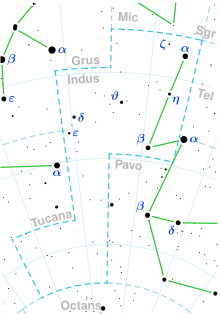Alpha Indi
| Observation data Epoch J2000 Equinox J2000 | |
|---|---|
| Constellation | Indus |
| Right ascension | 20h 37m 34.032s[1] |
| Declination | –47° 17′ 29.4052″[1] |
| Apparent magnitude (V) | 3.11[2] |
| Astrometry | |
| Radial velocity (Rv) | −1.3[3] km/s |
| Proper motion (μ) | RA: +50.922 mas/yr[1] Dec.: +66.026 mas/yr[1] |
| Parallax (π) | 32.8989 ± 0.2225 mas[1] |
| Distance | 99.1 ± 0.7 ly (30.4 ± 0.2 pc)[1] |
| Absolute magnitude (MV) | 0.78±0.03[4] |
| Characteristics | |
| Evolutionary stage | between subgiant and giant star |
| Spectral type | K0 III–IV[5] |
| U−B color index | +0.79[2] |
| B−V color index | +1.00[2] |
| Details[4] | |
| Mass | 2.15±0.13 M☉ |
| Radius | 9.89±0.21 R☉ |
| Luminosity | 50.9±1.6 L☉ |
| Surface gravity (log g) | 2.73±0.094 cgs |
| Temperature | 4904±37 K |
| Metallicity [Fe/H] | −0.038±0.029 dex |
| Age | 1.572±0.273[6] Gyr |
| Other designations | |
| Database references | |
| SIMBAD | data |
Alpha Indi (α Ind, α Indi) is the brightest star in the southern constellation Indus. Parallax measurements imply that it is located about 100 light years from Earth.[1] It has an apparent visual magnitude of 3.22,[2] being readily visible to the naked eye, and has an absolute magnitude of +0.78.[4]
Characteristics
[edit]The stellar classification of Alpha Indi is K0 III-IV,[5] meaning that it has exhausted the hydrogen at its core and evolved away from the main sequence, being now halfway between a subgiant and a giant star. It is estimated to be 1.6 billion years old,[6] has 2.15 times the mass of the Sun, but has expanded to 9.9 times the radius of the Sun and irradiates 51 times its luminosity. The effective temperature of its photosphere is 4,900 K,[4] giving it the characteristic orange hue of a K-type star.[8] It may have two nearby M-type companion stars, which are located at least 2,000 AU from the primary.[9]
Nomenclature
[edit]Alpha Indi is the star's Bayer designation.[7] In China, this star is called Pe Sze where it also was known as the Persian, a title from the Jesuit missionaries.[10] The term Pe Sze is from the name of asterism 波斯 (Bō Sī, English: Persia). In Chinese astronomy, consequently, α Indi itself is known as 波斯二 (Bō Sī èr, English: the Second Star of Persia)[11]
References
[edit]- ^ a b c d e f Vallenari, A.; et al. (Gaia collaboration) (2023). "Gaia Data Release 3. Summary of the content and survey properties". Astronomy and Astrophysics. 674: A1. arXiv:2208.00211. Bibcode:2023A&A...674A...1G. doi:10.1051/0004-6361/202243940. S2CID 244398875. Gaia DR3 record for this source at VizieR.
- ^ a b c d Johnson, H. L.; et al. (1966), "UBVRIJKL photometry of the bright stars", Communications of the Lunar and Planetary Laboratory, 4 (99): 99, Bibcode:1966CoLPL...4...99J
- ^ Evans, D. S. (June 20–24, 1966), "The revision of the general catalogue of radial velocities", in Batten, Alan Henry; Heard, John Frederick (eds.), Determination of Radial Velocities and their Applications, Proceedings from IAU Symposium no. 30, vol. 30, University of Toronto: International Astronomical Union, p. 57, Bibcode:1967IAUS...30...57E
- ^ a b c d Ottoni, G.; Udry, S.; Ségransan, D.; Buldgen, G.; Lovis, C.; Eggenberger, P.; Pezzotti, C.; Adibekyan, V.; Marmier, M.; Mayor, M.; Santos, N. C.; Sousa, S. G.; Lagarde, N.; Charbonnel, C. (2022-01-01). "CORALIE radial-velocity search for companions around evolved stars (CASCADES). I. Sample definition and first results: Three new planets orbiting giant stars". Astronomy and Astrophysics. 657: A87. arXiv:2201.01528. Bibcode:2022A&A...657A..87O. doi:10.1051/0004-6361/202040078. ISSN 0004-6361. Alpha Indi's database entry at VizieR.
- ^ a b Gray, R. O.; et al. (July 2006), "Contributions to the Nearby Stars (NStars) Project: Spectroscopy of Stars Earlier than M0 within 40 parsecs: The Northern Sample I", The Astronomical Journal, 132 (1): 161–170, arXiv:astro-ph/0603770, Bibcode:2006AJ....132..161G, doi:10.1086/504637, S2CID 119476992
- ^ a b Gomes da Silva, J.; Santos, N. C.; Adibekyan, V.; Sousa, S. G.; Campante, T. L.; Figueira, P.; Bossini, D.; Delgado-Mena, E.; Monteiro, M. J. P. F. G.; de Laverny, P.; Recio-Blanco, A.; Lovis, C. (2021-02-01). "Stellar chromospheric activity of 1674 FGK stars from the AMBRE-HARPS sample. I. A catalogue of homogeneous chromospheric activity". Astronomy and Astrophysics. 646: A77. arXiv:2012.10199. Bibcode:2021A&A...646A..77G. doi:10.1051/0004-6361/202039765. ISSN 0004-6361. Alpha Indi's database entry at VizieR.
- ^ a b "alf Ind -- Star in double system", SIMBAD, Centre de Données astronomiques de Strasbourg, retrieved 2011-12-12
- ^ "The Colour of Stars", Australia Telescope, Outreach and Education, Commonwealth Scientific and Industrial Research Organisation, December 21, 2004, archived from the original on March 18, 2012, retrieved 2012-01-16
- ^ Kaler, James B., "THE PERSIAN (Alpha Indi)", Stars, University of Illinois, retrieved 2011-12-23
- ^ Star Name - R.H.Allen p. 246
- ^ (in Chinese) AEEA (Activities of Exhibition and Education in Astronomy) 天文教育資訊網 2006 年 7 月 30 日 Archived 2011-05-22 at the Wayback Machine)

